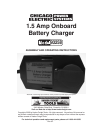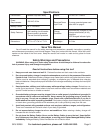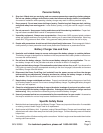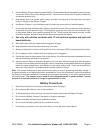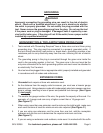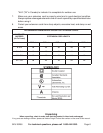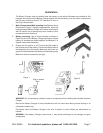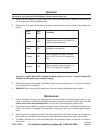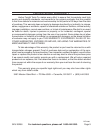Page 4SKU 93258
For technical questions, please call 1-800-444-3353.
4. Connect Battery Charger cables to proper polarities. Connect black cable to the negative battery terminal,
and the red cable to the positive battery terminal. Failure to do so could result in sparks, possible fire
and severe personal injury.
5. Keep cables clear of fan blades, belts, pulleys, and other moving parts of the engine that may cause
injury, or damage to the Battery Charger.
6. Use Battery Charger in well ventilated areas to prevent the accumulation of explosive gases.
7. Do not allow the Black and Red battery cables or terminals to touch. Failure to adhere to these directions
could result in severe personal injury. If this happens, sparks will occur that can melt connection lugs,
or other metal objects, and create the potential for fire. To help reduce the hazards involved, remove
all jewelry, watches, and other metal articles before working near the battery.
8. Use only with vehicles and boats with 12 volt electrical systems and lead-acid
based batteries.
9. Remove the keys from the vehicle before plugging in charger.
10. Keep extension cord off the ground and away from water.
11. Always connect the Line Cord to a Ground Fault Circuit Interrupter (GFCI) protected electrical outlet.
12. Do not attempt to start a vehicle while this charging unit is plugged in.
13. Periodically check on the progress of the trickle charge. Do not leave this product unattended for hours
without periodically checking on it’s operation.
14. Working near an engine is inherently dangerous: fans can start without warning even with the ignition
off, belts will move rapidly while the engine is running, hazardous and flammable materials are present
within the engine compartment, and radiator fins can cause serious cuts. If you are not qualified to
work near such hazards, a qualified mechanic should install the charger.
Note: The charger is designed to work automatically, cycling on and off by sensing the battery voltage. It
is mentioned above to not leave this product unattended for hours; this is because in some circumstances
the Battery Charger can overheat if it is attempting to recharge a low battery, or one that is damaged or has
sulfonated plates. The charger is to be used on fully charged batteries in good condition. Its only
purpose is to maintain the level of charge at approximately 12 volts.
Battery Precautions
1. Read all instructions and warnings on the battery before charging it.
2. Do not expose the battery to rain or wet conditions.
3. To avoid damage of cable and plug, never pull the cable to disconnect the Battery Charger.
4. Do not use the Battery Charger if the cables or plugs are damaged.
5. Repairs should be carried out by a qualified technician.
6. Do not touch the battery poles with any conductive source.
7. If the battery is removed, do not store the battery in a box with other metal objects.



